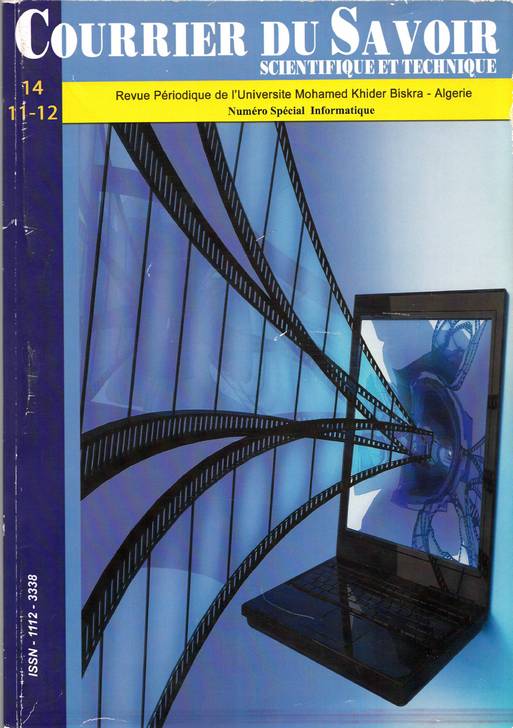INTENSITY ESTIMATIONOF UNKNOWN EXPRESSION BASED ON A STUDY OF FACIAL PERMANENT FEATURES DEFORMATIONS
Résumé
In this work we report on the progress of building a system that enables the intensity estimation ofunknown expression based
on a study of the degree of facial permanent features deformations from still images. The facial changes can be identified as
facial action units which correspond to the movement of muscles. We analyze subtle changes in facial expression by
interpreting the movement of the muscle by its corresponding distances computed from characteristic facial points. All
changed distances, are compared with corresponding Thresholds, to be mapped to symbolic states that qualitatively encode
how much a given distance differs from its corresponding value in the neutral state. The Transferable Belief Model is used to
fuse all data which correspond to the whole of changed distances. Expression intensity is quantifiedas: High, medium or low.
Different raisons are done to prove that is better to estimate expression intensity of unknown expression than of known one.
Références
action coding system: A technique for the measurement of
facial movement" Psychology, Physiological 1978, 2002.
ISBN 0-931835-01-1 1.
[2] K.Mase, “Recognition of facial expression from opticzal
flow”. IEICE Trans. E, vol. 74,n°10 , pp 3474-3483 1991.
[3] I. Essa and A. Pentland, 1997 “Coding, analysis,
interpretation, and recognition of facial expressions”. IEEE
Trans. on Pattern Analysis and Machine Intell., 19(7):757–
763.
[4] S. Kimura and M. Yachida, 1997 “Facial expression
recognition and its degree estimation”. In Proc. Of the Int.
Conf. on Computer Vision and Pattern Recognition, 295–
300.
[5] J.J. Lien, T. Kanade, J. Cohn, and C. Li, 1998 “Subtly
different facial expression recognition and expression
[6] Intensity estimation”. In Proc. of the IEEE Int. Conf. on
Computer Vision and Pattern Recognition, 853–859.
[7] M. Bartlett, J. Hager, P.Ekman, and T. Sejnowski, 1999.
“Measuring facial expressions by computer image analysis”.
Psychophysiology, 36:253–264.
[8] Y.-L. Tian, T. Kanade, and J. Cohn, Sept 2000 “Eye-state
action unit detection by Gabor wavelets”. In Proc. of Int.
Conf. on Multi-modal Interfaces, 143–150.
[9] J.N Bassili. Emotion Recognition: The role of facial
movements and the relative importance of upper and lower
areas of the face. Journal of personality and social
psychology. vol. 61, no. 11, pp. 298-307, 1979.
[10] Hammal Z., Caplier A. and Rombaut M. “A fusion process
based on belief theory classification of facial basic
emotions”. Proc. the 8th International Conference on
Information fusion, (ISIF), Philadelphia, PA, USA, 2005.
[11] A. Dempster, 1967 “Upper and lower probability inferences
based on a sample from a finite univariate”. Biometrika, 54:
515-528.
[12] Shafer, Glenn, 1976. A Mathematical Theory of Evidence.
Princeton University Press.
[13] [13] P. Smets, R. Kennes, 1994 “The Transferable Belief
Model”. Artificial Inteligence, 66 (2): 191-234.
[14] K.Ghanem, A.Caplier “Estimation of Facial Expression
Intensity Based on the Belief Theory” VISAPP
[15] 2008: Proc. the Third International Conference on Computer
Vision Theory and Applications, Funchal, Madeira,Portugal,
-Volume 1 452-460,2008.
[16] Hammal_CaplierDatabase : :
[17] http://www.lis.inpg.fr/pages_perso/caplier/english/emotionn
elle.html.en/emotionnelle_2.html.en.html.
[18] EEBase data base
http://www.cs.cmu.edu/afs/cs/project/cil/ftp/html/vimages.html.
[19] Dafex Database:
http://tcc.itc.it/research.i3p/dafex/index.html.
[20] Ekman, P. Facial asymmetry. Science, 209, 833-834. (1980).
[21] Cohn, J. F., & Schmidt, K. L. The timing of facial motion in
posed and spontaneous smiles. International Journal of
Wavelets, Multiresolution and Information Processing, 2, 1-12 (2004).


